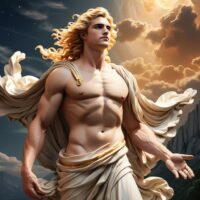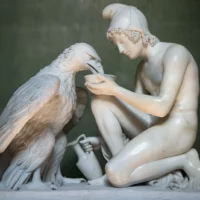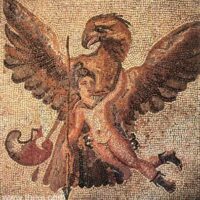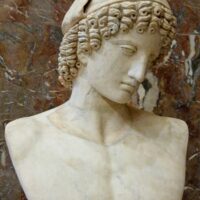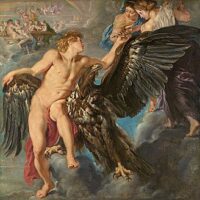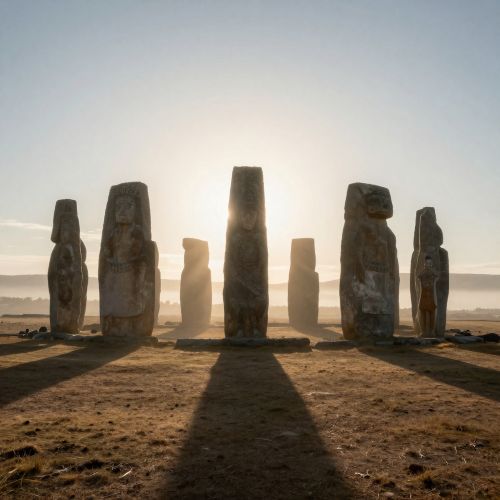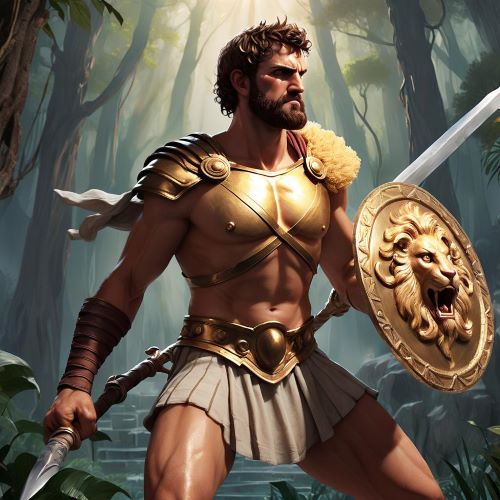Ganymede : The Handsome Cupbearer
Listen
At a glance
| Description | |
|---|---|
| Origin | Greek Mythology |
| Classification | Mortals |
| Family Members | King Tros (Father), Queen Callirrhoe (Mother) |
| Region | Greece |
| Associated With | Beauty |
Ganymede
Introduction
Ganymede stands out in Greek mythology as a symbol of beauty, transformation, and divine favor. A mortal youth of Trojan royalty, his story took an extraordinary turn when Zeus, enamored by his unmatched appearance, brought him to Mount Olympus. Unlike typical mythological tales of conquest or tragedy, Ganymede’s narrative is marked by ascension—both literal and symbolic—as he transitioned from a human prince to a divine companion of the gods. This myth has remained a powerful metaphor for youth, idealized love, and celestial favor, resonating deeply across art, literature, and modern identity narratives.
Physical Traits
Ganymede’s appearance captivated gods and mortals alike. In ancient texts and sculptures, he is consistently portrayed with a lithe and graceful frame, often with golden curls cascading down his shoulders and an expression that blends innocence with poise. His aesthetic is described not only as beautiful but almost supernatural, evoking the kind of ethereal charm that made him seem destined for the heavens. Unlike the rugged heroism of many Greek figures, Ganymede’s allure lies in gentleness and radiance—features that emphasized the ideal of youthful beauty in classical culture.
Family
As the son of King Tros, founder of Troy, and the nymph Callirrhoe, Ganymede’s heritage linked him to both mortal nobility and divine ancestry. This lineage not only grounded him in the royal house of Troy but also reinforced his status as someone worthy of the gods’ attention. His brothers—Ilus, credited with founding the city of Ilium, and Assaracus, an ancestor of Aeneas—further positioned his family as central figures in the mythological foundation of Troy. Ganymede’s place in this lineage added gravitas to his story, suggesting that his fate was part of a divine design rather than mere chance.
Other names
While “Ganymede” is the most widely recognized name, especially in Greek sources, he also appears under different titles depending on the cultural lens. The Romans knew him as Catamitus, a name that, over time, took on broader connotations related to youth and beauty. In poetic or philosophical works, he was sometimes referred to with epithets that emphasized his role as a beloved or divine servant. These alternate names show how his myth was adapted across languages and periods, often reflecting shifting attitudes toward youth, divinity, and relationships between mortals and gods.
Powers and Abilities
Though Ganymede was not born a god, his elevation by Zeus granted him immortality and eternal youth—gifts few mortals ever received. As cupbearer to the gods, he had the sacred duty of serving nectar and ambrosia at divine feasts, a position of trust and prestige. More than a servant, Ganymede became a constant presence among the Olympians, his role often symbolizing the preservation of divine harmony and youth. His association with Aquarius, the water-bearer constellation, later transformed his myth into a celestial symbol, linking him eternally with the heavens.
Modern Day Influence
Ganymede’s story has had a profound influence on art, astronomy, and social discourse. The most prominent tribute lies in the naming of Jupiter’s largest moon, Ganymede, discovered by Galileo in 1610—fitting, as Jupiter is the Roman counterpart of Zeus. In visual art, Renaissance and Baroque masters such as Michelangelo, Correggio, and Rubens reimagined his myth through sensual, often provocative works that highlighted themes of divine attraction and ascension.
Beyond classical art, Ganymede has become a cultural icon, especially within LGBTQ+ contexts. His story is often interpreted as an early representation of same-sex affection and divine acceptance, resonating in discussions about identity, love, and societal roles. Contemporary authors, playwrights, and scholars revisit his myth not just for its beauty, but for its symbolic potential as a bridge between the earthly and the transcendent, the mortal and the immortal.
Related Images
Source
Hamilton, Edith. Mythology: Timeless Tales of Gods and Heroes. Grand Central Publishing, 1998.
Graves, Robert. The Greek Myths. Penguin Books, 2011.
Buxton, Richard. The Complete World of Greek Mythology. Thames & Hudson, 2004.
Frequently Asked Questions
What is lorem Ipsum?
I am text block. Click edit button to change this text. Lorem ipsum dolor sit amet, consectetur adipiscing elit. Ut elit tellus, luctus nec ullamcorper mattis, pulvinar dapibus leo.
What is lorem Ipsum?
I am text block. Click edit button to change this text. Lorem ipsum dolor sit amet, consectetur adipiscing elit. Ut elit tellus, luctus nec ullamcorper mattis, pulvinar dapibus leo.
What is lorem Ipsum?
I am text block. Click edit button to change this text. Lorem ipsum dolor sit amet, consectetur adipiscing elit. Ut elit tellus, luctus nec ullamcorper mattis, pulvinar dapibus leo.
What is lorem Ipsum?
I am text block. Click edit button to change this text. Lorem ipsum dolor sit amet, consectetur adipiscing elit. Ut elit tellus, luctus nec ullamcorper mattis, pulvinar dapibus leo.
What is lorem Ipsum?
I am text block. Click edit button to change this text. Lorem ipsum dolor sit amet, consectetur adipiscing elit. Ut elit tellus, luctus nec ullamcorper mattis, pulvinar dapibus leo.


